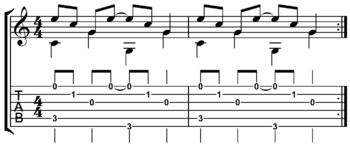- Accompaniment
-
In music, accompaniment is the art of playing along with an instrumental or vocal soloist or ensemble, often known as the lead, in a supporting manner. The accompaniment can be performed by a single performer--a pianist, organist, or guitarist--or it can be played by an entire ensemble, such as a symphony orchestra or string quartet (in the Classical genre) or a backing band or rhythm section (in popular music) or a Big Band or organ trio (in jazz). It may be considered the background to the foreground melody. The term "accompaniment" is also used to describe the composed music, arrangement, or improvised performance that is played to back up the soloist. In most Classical styles, the accompaniment part is written by the composer and provided to the performers in the form of sheet music. In jazz and popular music, the backing band or rhythm section may improvise the accompaniment based on standard forms--in the case of a small blues band or jazz band playing a 12 bar blues progression--or the band may play from a written arrangement in a jazz Big Band or in a musical theater show.
The accompaniment part usually provides the harmonic background and the rhythmic structure for the piece of music or song. The harmonic background is usually provided by one or more instruments that play a chord progression. Instruments commonly used to play chords (also called harmonic accompaniment) include the (acoustic or electric) guitar, piano, organ and electronic keyboards. An accompaniment can also be provided by instruments that normally play the melody, such as the violin (e.g., if a musical arrangement is written for several violins which will set out the chord progression). The accompaniment often includes a bass instrument which plays the bass notes of the harmonic progression (e.g., bass guitar, upright bass, etc.). The rhythmic structure of the piece or song is typically provided by drums or percussion in most types of popular music, jazz, and blues. In Classical music styles, there are many types of pieces which do not include percussion instruments, such as string quartets and organ trios.
In most tonal music the melody and accompaniment are written from and share the same group of pitches, while in much atonal music the melody and accompaniment are chosen from entirely separate groups of pitches, often from different hexachords. See also: chord-based.
An accompanist is one who plays an accompaniment. A number of classical pianists have become famous as accompanists rather than soloists; the best known example is probably Gerald Moore, well known as a Lieder accompanist. In some American schools, the title collaborative pianist (or collaborative artist) is replacing the title accompanist.
An accompaniment figure is a musical gesture used repeatedly in an accompaniment, such as:
- Alberti bass and other arpeggio figures
- Ostinati figures (repeated lines) or , in popular music, riffs
Notated accompaniment may be indicated obbligato (obliged) or ad libitum (at one's pleasure).
Dialogue accompaniment is a form of call and response in which the lead and accompaniment alternate, the accompaniment playing during the rests of the lead and providing a drone or silence during the main melody or vocal.[2]
Basso continuo is a form of notation used especially in Baroque music accompaniment parts.
The term accompanist is also used to refer to a musician (generally pianist) who will not necessarily be participating in the performance of a piece of drama that utilizes music (musical theater, opera, etc.) but is used during an audition or rehearsal in lieu of the actual musician(s).
See also
References
- ^ Traum, Happy (1974). Fingerpicking Styles For Guitar, p.12. Oak Publications. ISBN 0825600057. Hardcover (2005): ISBN 0825603439.
- ^ van der Merwe, Peter (1989). Origins of the Popular Style: The Antecedents of Twentieth-Century Popular Music, p.320. Oxford: Clarendon Press. ISBN 0-19-316121-4.
Accompaniment · Banjo roll · Cadence · Chord · Chord progression · Harmonization · List of chords · List of chord progressions · Note · Pitch · Simultaneity · Voice leadingCategories:
Wikimedia Foundation. 2010.



